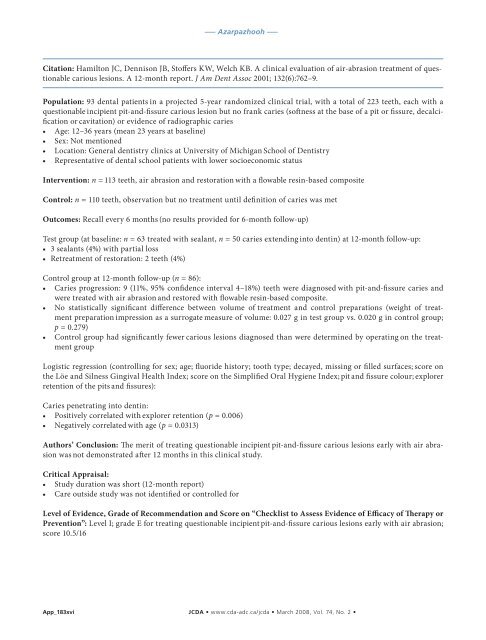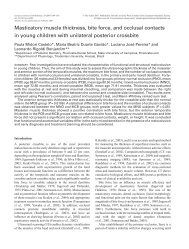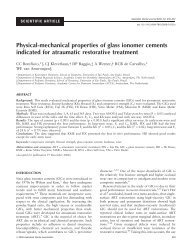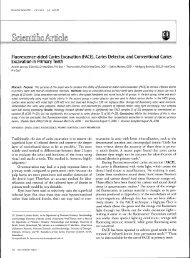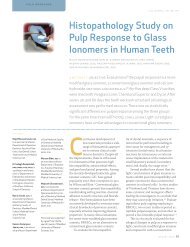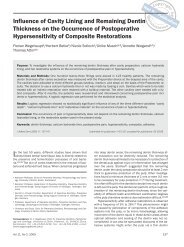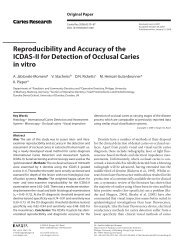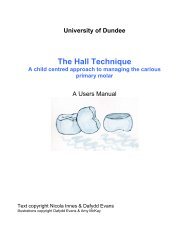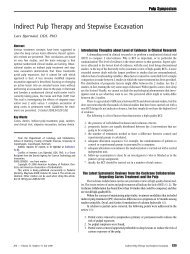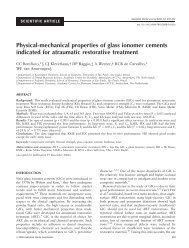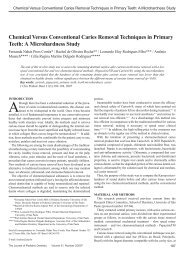Pit and Fissure Sealants in the Prevention of Dental Caries in ...
Pit and Fissure Sealants in the Prevention of Dental Caries in ...
Pit and Fissure Sealants in the Prevention of Dental Caries in ...
Create successful ePaper yourself
Turn your PDF publications into a flip-book with our unique Google optimized e-Paper software.
––– Azarpazhooh –––<br />
Citation: Hamilton JC, Dennison JB, St<strong>of</strong>fers KW, Welch KB. A cl<strong>in</strong>ical evaluation <strong>of</strong> air-abrasion treatment <strong>of</strong> questionable<br />
carious lesions. A 12-month report. J Am Dent Assoc 2001; 132(6):762–9.<br />
Population: 93 dental patients <strong>in</strong> a projected 5-year r<strong>and</strong>omized cl<strong>in</strong>ical trial, with a total <strong>of</strong> 223 teeth, each with a<br />
questionable <strong>in</strong>cipient pit-<strong>and</strong>-fissure carious lesion but no frank caries (s<strong>of</strong>tness at <strong>the</strong> base <strong>of</strong> a pit or fissure, decalcification<br />
or cavitation) or evidence <strong>of</strong> radiographic caries<br />
• Age: 12–36 years (mean 23 years at basel<strong>in</strong>e)<br />
• Sex: Not mentioned<br />
• Location: General dentistry cl<strong>in</strong>ics at University <strong>of</strong> Michigan School <strong>of</strong> Dentistry<br />
• Representative <strong>of</strong> dental school patients with lower socioeconomic status<br />
Intervention: n = 113 teeth, air abrasion <strong>and</strong> restoration with a flowable res<strong>in</strong>-based composite<br />
Control: n = 110 teeth, observation but no treatment until def<strong>in</strong>ition <strong>of</strong> caries was met<br />
Outcomes: Recall every 6 months (no results provided for 6-month follow-up)<br />
Test group (at basel<strong>in</strong>e: n = 63 treated with sealant, n = 50 caries extend<strong>in</strong>g <strong>in</strong>to dent<strong>in</strong>) at 12-month follow-up:<br />
• 3 sealants (4%) with partial loss<br />
• Retreatment <strong>of</strong> restoration: 2 teeth (4%)<br />
Control group at 12-month follow-up (n = 86):<br />
• <strong>Caries</strong> progression: 9 (11%, 95% confidence <strong>in</strong>terval 4–18%) teeth were diagnosed with pit-<strong>and</strong>-fissure caries <strong>and</strong><br />
were treated with air abrasion <strong>and</strong> restored with flowable res<strong>in</strong>-based composite.<br />
• No statistically significant difference between volume <strong>of</strong> treatment <strong>and</strong> control preparations (weight <strong>of</strong> treatment<br />
preparation impression as a surrogate measure <strong>of</strong> volume: 0.027 g <strong>in</strong> test group vs. 0.020 g <strong>in</strong> control group;<br />
p = 0.279)<br />
• Control group had significantly fewer carious lesions diagnosed than were determ<strong>in</strong>ed by operat<strong>in</strong>g on <strong>the</strong> treatment<br />
group<br />
Logistic regression (controll<strong>in</strong>g for sex; age; fluoride history; tooth type; decayed, miss<strong>in</strong>g or filled surfaces; score on<br />
<strong>the</strong> Löe <strong>and</strong> Silness G<strong>in</strong>gival Health Index; score on <strong>the</strong> Simplified Oral Hygiene Index; pit <strong>and</strong> fissure colour; explorer<br />
retention <strong>of</strong> <strong>the</strong> pits <strong>and</strong> fissures):<br />
<strong>Caries</strong> penetrat<strong>in</strong>g <strong>in</strong>to dent<strong>in</strong>:<br />
• Positively correlated with explorer retention (p = 0.006)<br />
• Negatively correlated with age (p = 0.0313)<br />
Authors’ Conclusion: The merit <strong>of</strong> treat<strong>in</strong>g questionable <strong>in</strong>cipient pit-<strong>and</strong>-fissure carious lesions early with air abrasion<br />
was not demonstrated after 12 months <strong>in</strong> this cl<strong>in</strong>ical study.<br />
Critical Appraisal:<br />
• Study duration was short (12-month report)<br />
• Care outside study was not identified or controlled for<br />
Level <strong>of</strong> Evidence, Grade <strong>of</strong> Recommendation <strong>and</strong> Score on “Checklist to Assess Evidence <strong>of</strong> Efficacy <strong>of</strong> Therapy or<br />
<strong>Prevention</strong>”: Level I; grade E for treat<strong>in</strong>g questionable <strong>in</strong>cipient pit-<strong>and</strong>-fissure carious lesions early with air abrasion;<br />
score 10.5/16<br />
App_183xvi<br />
JCDA • www.cda-adc.ca/jcda • March 2008, Vol. 74, No. 2 •


